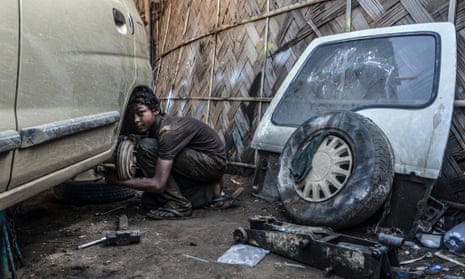The Indian government is making severe cuts to budgets that address discrimination and the welfare of the country’s most marginalised people. In a deeply flawed strategy, they are relaxing legislation on child labour as a means to alleviate poverty.
An amendment to India’s Child Labour Prohibition Act seeks to permit children under 14 to work in “family enterprises”, a euphemism for industries such as carpet-weaving, beedi (cigarette) rolling and gem-polishing. Altering the act that was otherwise set to make all forms of child labour illegal will push millions of children into work rather than education, particularly Dalits (those at the bottom of India’s caste system), Adivasis and Muslims.
India’s minister of labour and employment, Bandaru Dattatreya, has argued that the amendment, which has just been approved by the union cabinet, will help impoverished families earn a living and give children an “entrepreneurial spirit”. He also contends that children are only allowed to engage in work that will not interfere with their education.
However, the widespread failure to enforce the rule of law across India means that permitting child labour of any kind will overturn progress in getting children out of work and into school. Officials are already underreporting child labour, and accountability will not be improved if particular forms of child labour are permitted.
The government argument that allowing children to work in family enterprises will help families overcome poverty is strongly countered by many experts on child labour, including the Nobel peace prize winner Kailash Satyarthi, who criticised the amendment in an opinion piece in the Times of India.
There is no proof that allowing children to work will alleviate poverty. On the contrary, evidence suggests that children are used instead of adults, who are then unemployed because children are easier to exploit and control. It condemns children, especially Dalit children, to a life of exclusion, discrimination and low-paid jobs.
Child labour in India predominantly affects the lowest castes, in particular Dalit, Adivasi and Muslim children. They are often forced to work because of their family’s marginalised status and lack of alternatives. These groups are particularly vulnerable to being trafficked into slavery, a road that becomes all the more open to children by allowing them to work “in their spare time”.
Education is key to breaking out of poverty and marginalisation. In India, access to education for groups who suffer discrimination is already severely limited due to prejudice and poverty. According to the UN children’s agency, Unicef, Dalit girls have the highest rate of exclusion from primary school in India and the highest dropout rates, a tendency that will not be curbed by legitimising child labour in their free time.
If the Indian government is serious about curbing poverty, it should prioritise budgets for education and enforce legislation that will protect marginalised children, creating inclusive school spaces that will act as an incentive for children to stay in school rather than drop out in order to work.
The government must also address the endemic structural discrimination that goes to the root of the problem and ensure an education for girls and other marginalised children. This includes directly and openly addressing caste-based discrimination, which affects the lives of 200 million Dalits in India.
Despite espousing the cause of bridging caste, gender and communal divides, the government is failing to make this a priority and recently made severe cuts to education budgets, including slashing 57% off figures meant for the welfare and education of Dalits and Adivasis.
Supporting the right to education among marginalised groups in India must be made a political, economic, and social priority if we are to take commitments to alleviate poverty seriously. The upholding of rights in India and the enforcement of the country’s legislation would in itself create significant progress in the fight against poverty and child labour.
With the amendment proposed to the new child labour law coupled with the severe cuts on welfare and education, the government is instead set to send millions of marginalised children out of school and into work, trapping families in a cycle of poverty for yet another generation to come.
- Rikke Nöhrlind is executive director of International Dalit Solidarity Network. Gerard Oonk is a child labour expert and director of the India Committee of the Netherlands
